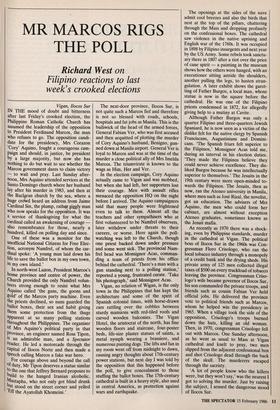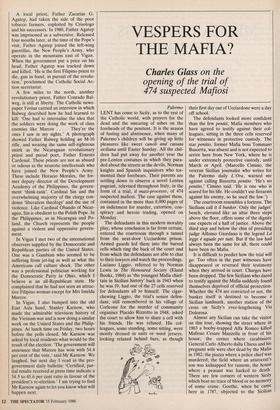MR MARCOS RIGS THE POLL
Richard West on
Filipino reactions to last week's crooked elections
Vigan, Ilocos Sur IN THE mood of doubt and bitterness after last Friday's crooked election, the Philippine Roman Catholic Church has assumed the leadership of the opposition to President Ferdinand Marcos, the man Who refuses to go. The opposition candi- date for the presidency, Mrs Corazon 'Cory' Aquino, fought a courageous cam- Paign and should, in justice, be president by a large majority, but now she has nothing to do but wait to see whether the Marcos government dares to claim victory — to wait and pray. Last Sunday after- noon, Mrs Aquino attended services at the Santo Domingo church where her husband lay after his murder in 1983, and then at the Baclaran church by the sea, where a huge crowd heard an address from Jaime Cardinal Sin, the plump, rather giggly man Who now speaks for the opposition. It was a service of thanksgiving for what the cardinal called an awakening of courage — also remembrance for those, nearly a hundred, killed on polling day and since.
One of these was a monitor for the unofficial National Citizens for Free Elec- tion, acronym Namfrel, of whom the car- dinal spoke: 'A young man laid down his life to save the ballot box in my own town, in my own island.'
In north-west Luzon, President Marcos's home province and centre of power, the Church provided the only Namfrel volun- teers strong enough to resist what Mrs Aquino called 'the guns, the goons and gold' of the Marcos party machine. Even the priests declined, so nuns guarded the ballot boxes, their sex and habit giving them some protection from the thugs apparent at so many polling stations throughout the Philippines. The organiser Of Mrs Aquino's political party in that province, an engineer named Ross Tipon, ls an admirable man, and a Spectator reader. He led a motorcade through the capital of Ilocos Norte and then made a speech calling Marcos a fake war hero. For courage above and beyond the call of duty, Mr Tipon deserves a statue similar to the one that Jeffrey Bernard proposes to build to the hanged Iranian alcoholic, Mustapha, who not only got blind drunk but stood on the street corner and yelled Eff the Ayatollah Khomeini.' The next-door province, Ilocos Sur, is not quite such a Marcos fief and therefore is not so blessed with roads, schools, hospitals and fat jobs as Manila. This is the bailiwick of the head of the armed forces, General Fabian Ver, who was first accused and then acquitted of plotting the murder of Cory Aquino's husband, Benigno, gun- ned down at Manila airport. General Ver is loyal to Marcos and was at the time of the murder a close political ally of Mrs Imelda Marcos. The triumvirate is known to the wags as Him, Her and Ver.
In the election campaign, Cory Aquino actually came to Vigan and was mobbed, but when she had left, her supporters lost their courage. Men with assault rifles menaced the opposition HQ on the night before I arrived. The Aquino campaigners said that many people were frightened even to talk to them. Almost all the teachers and other sympathisers who at first volunteered to be Namfrel observers, later withdrew under threats to their careers, or worse. Here again the poll- watching was left to the Church, though one priest backed down under pressure and some went sick. The provincial Nam- frel head was Monsignor Acas, comman- ding a team of priests from his office behind the cathedral. 'There's a man with a gun standing next to a polling station,' reported a young, frustrated curate. 'Take his photograph,' said Monsignor Acas. Vigan, no relation of Wigan, is the only town in the Philippines that has kept the architecture and some of the spirit of Spanish colonial times, with horse-drawn cars rattling over the cobbles between sturdy mansions with red-tiled roofs and carved wooden balconies. The Vigan Hotel, the aristocrat of the north, has fine wooden floors and staircase, four-poster beds, life-size plaster statues of saints, a metal nymph wearing a brassiere, and numerous panting dogs. The lifts and fan in my room went off from midnight to dawn, causing angry thoughts about 17th-century power stations, but next day I was told by the opposition that this happened before the poll, to give concealment to those stuffing the ballot boxes. The 17th-century cathedral is built in a heavy style, also used in central America, as protection against wars and earthquake. The openings at the sides of the nave admit cool breezes and also the birds that nest at the top of the pillars, chattering through the Mass and dropping profusely on the confessional boxes. The cathedral saw violence in the native uprising and English war of the 1760s. It was occupied in 1898 by Filipino insurgents and next year by the US Army. Some rebels took sanctu- ary there in 1807 after a riot over the price of cane spirit — a painting in the museum shows how the others were hanged, with an executioner sitting astride the shoulders, another pulling the legs, to hasten stran- gulation. A later exhibit shows the garot- ting of Father Burgos, a local man, whose statue is now in the square before the cathedral. He was one of the Filipino priests condemned in 1872, for allegedly giving help to a mutiny at Cavite.
Although Father Burgos was only a quarter Filipino and three-quarters Jewish Spaniard, he is now seen as a victim of the dislike felt for the native clergy by Spanish Franciscans, Augustinians and Domini- cans. 'The Spanish friars felt superior to the Filipinos,' Monsignor Acas told me, during an interval in his election duties. 'They made the Filipinos believe they could never achieve excellence. They dis- liked Burgos because he was intellectually superior to themselves.' The Jesuits in the 19th century were more open-minded to- wards the Filipinos. The Jesuits, then as now, ran the Ateneo university in Manila, where men such as Jose Rizal, the novelist, got an education. The advisers of Mrs Aquino, the men who could form her cabinet, are almost without exception Ateneo graduates, sometimes known as the Jesuit mafia.
As recently as 1970 there was a shock- ing, even by Philippine standards, murder in the cathedral at Vigan. The political boss of Ilocos Sur in the 1960s was Con- gressman Floro Crisologo, who ran the local tobacco industry through a monopoly of a credit bank and the drying sheds. His private army of 125 men collected illegal taxes of $500 on every truckload of tobacco leaving the province. Congressman Criso- logo's wife became governor of Ilocos Sur, his son commanded the private troops, and friends such as cousin Fabian Ver held official jobs. He delivered the province vote to political friends such as Marcos, whom he helped win the presidency in 1965. When a village took the side of the opposition, Crisologo's troops burned down the huts, killing an old woman. Then, in 1970, congressman Crisologo fell out with Marcos. One Sunday afternoon, as he went as usual to Mass at Vigan cathedral and knelt to pray, two men slipped from the adjacent confessional box and shot Crisologo dead through the back of the skull. The murderers escaped through the sacristy.
'A lot of people know who the killers were, but they won't say,' was the nearest I got to solving the murder. Just by raising the subject, I sensed the dangerous mood of Ilocos Sur. A local priest, Father Zacarias G. Agatep, had taken the side of the poor tobacco farmers, exploited by Crisologo and his successors. In 1980, Father Agatep was imprisoned as a subversive. Released four months later, at the time of the Pope's visit, Father Agatep joined the left-wing guerrillas, the New People's Army, who operate in the mountains east of Vigan. When the government put a price on his head, Father Agatep was tracked down and killed. 'He is the first Filipino priest to die, gun in hand, in pursuit of the revolu- tion,' proclaimed the Catholic Social Ac- tion secretariat.
A few miles to the north, another revolutionary priest, Father Conrado Bal- weg, is still at liberty. The Catholic news paper Veritas carried an interview in which Balweg described how he had learned to kill: 'One had to internalise the idea that the soldiers were doing the work of class enemies like Marcos . . . . They're the ones I saw in my sights.' A photograph showed Father Balweg holding an M-16 rifle, and wearing the same self-righteous smirk as the Nicaraguan revolutionary priest and pseud poet, Father Ernesto Cardenal. These priests are not as absurd or odious as the neurotic intellectuals who have joined the New People's Army. These include Horacio Morales, the for- mer deputy director of the Development Academy of the Philippines, the govern- ment `think-tank'. Cardinal Sin and the overwhelming majority of the clergy con- demn 'liberation theology' and the use of violence. Like Cardinal Obando of Nicar- agua, Sin is obedient to the Polish Pope. In the Philippines, as in Nicaragua and Po- land, the Church represents the people against a violent and oppressive govern- ment.
In Vigan I met two of the international observers supplied by the Democratic and Republican parties of the United States. One was a Gambian who seemed to be suffering from jet-lag as well as what the Americans call culture shock. The other was a professional politician working for the Democratic Party in Ohio, which I believe is an all-Republican state. He complained that he had not seen an attrac- tive Filipino woman except for Mrs Imelda Marcos.
In Vigan, I also bumped into the old East Asia hand, Stanley Karnow, who made the admirable television history of the Vietnam war and is now doing a similar work on the United States and the Philip- pines. At lunch time on Friday, two hours before the polls closed, Mr Karnow was asked by local residents what would be the result of the election. 'The government will announce that Marcos has won with 54.4 per cent of the vote,' said Mr Karnow. We laughed, but next day I read in the pro- government daily bulletin: 'Certified, par- tial results received at press time indicate a 54.5 to 45.6 per cent ratio in favour of the president's re-election.' I am trying to find Mr Karnow again to let you know what will happen next.






































 Previous page
Previous page